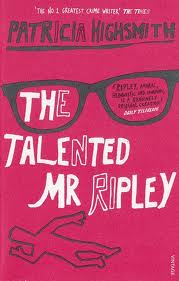Our book choice for November 2012 is The Talented Mr Ripley by Patricia Highsmith. LBG selected Highsmith’s first book, Strangers on a Train for Christmas 2010 and enjoyed her prose, even if the ending disappointed the group. In the first book of the Ripley series, Tom is a 23-year-old living in New York. He comes from a fairly disadvantaged background, having been grudgingly raised by an aunt after the death of his parents, but has aspirations to a better life.
An accomplished liar and fraudster, he is currently impersonating an agent of the income tax office and collecting supposedly overdue and unpaid taxes from his unsuspecting victims. However, this scam, apparently the latest in a series of dishonest schemes, is more of a silly game than a serious attempt to get money, as he cannot cash the checks he receives. Furthermore, it appears to have gone wrong and he is expecting imminent arrest when he is approached in a bar by Herbert Greenleaf, the wealthy father of a casual acquaintance. Mr. Greenleaf hires him to go to Italy to try to pursuade his son Dickie to come home. Dickie is living a bohemian life as a painter and sailor in a small Italian village called Mongibello.
When Tom tracks Dickie down, he finds that Dickie has what seems an enviable life. A trust fund gives him enough to live on and he owns a house by the sea and a boat. Tom quickly insinuates himself into Dickie’s life but kills him when he fears Dickie is growing tired of him. With his talent for impersonation and deceit, Tom is able to pass himself off as Dickie and completely takes over the lifestyle he has come to love and need.
A superficial resemblance between Tom and Dickie is enough to take in strangers, and Tom tricks Marge as to Dickie’s whereabouts. Tom is forced to shuttle back and forth between his two identities and avoid all Dickie’s former friends. A stroke of luck or sheer genius saves Tom from getting caught, even when he dares to pull of his most radical and desperate final scheme.
Discussion Questions
- How does the Tom in New York strike you? Lost, good?
- How does Tom’s character change over the course of the book? Is he basically the same person, set free from social bounds?
- I have a sneaking suspicion that Patricia Highsmith is a murderer … anyone else?
- Does Tom leave his better self behind in New York?
- Tom worries a lot about the ‘kind of people’ he associates with. Contrast Bob in New York with Paul on the boat – composer friend. Is this unforgiveable snobbery or something we all do at a young age? A sign of immaturity?
- Is Tom a solipsist, are other people an inconvenience to him?
- When Tom imagines a wonderful life it is full of furniture and nice shirts, not people. Are there parallels with Gatsby? He invents himself. Anyone else read Ameican Psycho? Crime and Punishment – the hero commits a crime and destroys himself from within from guilt.
- What did you make of the sequence where Tom moves from annoyance with Dickie to planning to murder him and take over his life. Sexual possession, triumph, marriage and finally murder?
- Where does the reader stand morally? A subversive thriller where the criminal is the hero.
- How does Highsmith use doubling as a recurring device in the book? What does it signify?
- Is Tom an opportunist? If so, what drives this tendency?
- Does Tom have an overactive imagination? Or is he just too sensitive?
- To whom would you recommend the novel?
Individual Ratings
DKB Rating 





